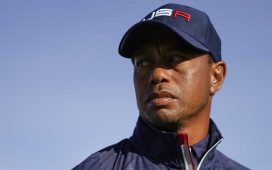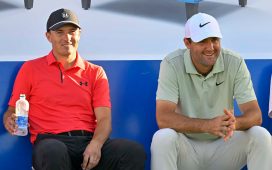Tiger Woods doesn’t just make golf history. He is also a student of it. And he knows full well the remarkable comeback story of Ben Hogan, one of the game’s greats.
The car crash that sent Woods to the hospital on Tuesday and into emergency surgery, where a rod was inserted into his right leg, carries echoes of Hogan’s crash 72 years ago this month. It isn’t certain if Woods will ever walk again, let alone golf. The same was true of Hogan a lifetime ago. And he came back to win six more majors.
That doesn’t mean something similar can happen for Woods, of course. Hogan was 36 and at the top of his game when a Greyhound bus slammed into his black Cadillac. Woods is 45, had his fifth back surgery in December, and suffered severe leg injuries in the accident. Still, Hogan’s story is worth remembering.
He and his wife, Valerie, were on their way back to their home in Fort Worth, Texas, from a tournament in Phoenix. They had driven about 500 miles east the first day and had another 500 or so to go on February 2, 1949. They set out from rural Van Horn, Texas, on a cold morning and had gone only about 10 miles on two-lane Highway 80 when they ran into heavy fog and a thin film of ice. Hogan slowed down to 25 miles per hour. That’s when, as he would later put it, he saw “four lights winking at me.”
The bus driver, trying to pass a truck in the fog, did not see the oncoming Cadillac. In that instant, Hogan knew they were going to get hit head-on. He hurled his body across the front seat to shield his wife — and it saved his life.
The steering column was found impaled in the driver’s seat. Hogan surely would have died on impact had he not had the instant instinct to protect Valerie. She would end up with minor injuries. He would be left with a fractured collarbone, a double fracture of the pelvis, a broken ankle, and a chipped rib, plus a left eye swollen nearly shut.
Hogan and his wife were left pinned against the dashboard. He was unconscious; she lowered her window and called for help. He came to and implored her to get out of the car lest it catch fire. Another driver came along and helped her drag Hogan out, but it would be 90 minutes before an ambulance arrived. Legend has it that as he was lifted into the ambulance, he asked Valerie if his clubs were secure. Yes, she said.
Hogan, at that moment, was the best golfer in the world. He had recently won two majors — the U.S. Open and the PGA Championship — and three weeks earlier his image had graced the cover of Time magazine. The story called him one of the greatest players in golf history. It also quoted him, hauntingly: “It isn’t the golf, it’s the traveling. I want to die an old man, not a young one.”
Doctors set Hogan’s bones and told reporters that a full recovery was possible. But weeks later came a setback they had not seen coming. Blood clots had formed in his legs after a couple of weeks in bed, and one of the clots had traveled to his lungs. Doctors performed emergency surgery to tie off the vein that carries blood from the lower half of the body to the heart. No one was talking about him playing golf at this point. Now they were worried for his life.
Hogan, who stood 5-8½ and weighed 140 pounds, spent another month in bed before he was released from the hospital 20 pounds lighter. He got home at the end of March. By summer, he was still too weak even to swing a club. Walking wore him out. He told reporters his nervous system was shot, and he didn’t see how he could go back to competitive golf, though he would try.
“Don’t believe a word of it,” Valerie assured them. “Ben will be himself again.”
She was right, up to a point. Hogan would play again, and play surpassingly well, but his legs swelled painfully and he suffered chronic fatigue. The man who had often led the tour in money winnings would have to pick his spots going forward, never again playing in more than seven PGA Tour events in a season.
Eleven months after the accident, Hogan returned for the Los Angeles Open at the Riviera Country Club. (As it happens, that’s where Woods was last weekend, as the host of the a nonplaying guest at the Genesis Invitational.) There Hogan and Sam Snead were tied after 72 holes. Snead won the 18-hole playoff, and Grantland Rice wrote of Hogan: “His legs simply were not strong enough to carry his heart any longer.”
Then, in June 1950, at the U.S. Open at the Merion Country Club, outside Philadelphia, Hogan hit one of golf’s most legendary shots — with a 1-iron. (Lee Trevino once said the best way to avoid being hit by lightning is to stand in the middle of the fairway and hold up a 1-iron, because “even God can’t hit a 1-iron.”) Hogan could, and his shot on 18 over a grassed-over quarry found the green. Then he two-putted for par to force an 18-hole, three-way playoff. This time his legs matched his heart: Hogan beat Lloyd Mangrum and George Fazio in what came to be known as the “Miracle at Merion.”
Hogan won PGA Tour events 13 times after his accident, including six majors, for his career total of nine major championships. This included his otherworldly 1953 season, in which he won five of the six events he entered, including three majors and all in dominating fashion — the Masters by six strokes, the U.S. Open by six, and the Open Championship, in Scotland, by four. “The Scots took to Hogan,” wrote John Barton in Golf World, “because he was understated, muted, polite. The quiet American.”
They threw a loud tickertape parade for the quiet American in New York after that one. Hogan didn’t have a chance for the Grand Slam, because he didn’t compete in the other major that year; the PGA was match play then, which required walking as many as 36 holes on some days.
If all this sounds like a Hollywood script, well, it was. The 1951 biopic “Follow the Sun” was a based-on-a-true-story telling of Hogan’s life, with Glenn Ford in the title role. The poster for its theatrical release showed a smashed-up car and called it “The real-life love story of two kids from Texas.”
The love story came to a close in 1997, when Hogan died at 84 — an old man, not a young one, as he had told Time. He and Valerie had been married for 62 years.
Tiger Woods knows the history. Here is what he told reporters at the Masters in 2018: “I think one of the greatest comebacks in all of sports is the gentleman who won here, Mr. Ben Hogan. I mean, he got hit by a bus and came back and won major championships. The pain he had to endure, the things he had to do just to play, and just how hard it was for him to walk.”
And now the world wishes Mr. Woods a happy ending of his own.








